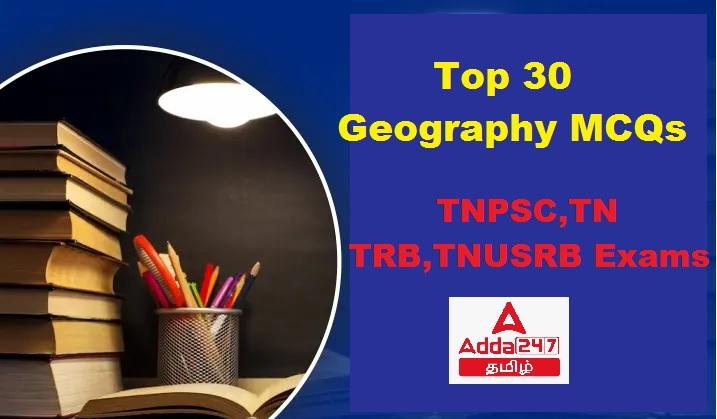பல்வேறு போட்டித் தேர்வுகளில் புவியியல் முக்கியப் பங்காற்றுகிறது, விண்ணப்பதாரர்களுக்கு அவர்களின் தயாரிப்பில் உதவ, நாங்கள் 30 கேள்விகளை (MCQs) தொகுத்துள்ளோம். உங்கள் புவியியல் அறிவை மேம்படுத்துவதற்கும், வரவிருக்கும் தேர்வுகளுக்கு உங்களை சிறப்பாக தயார்படுத்துவதற்கும் ஒவ்வொரு கேள்விக்கும் சரியான பதில் உள்ளது.
Q1. Layer of earth that is dominated by organic material is _______.
- a) O horizon
- b) A horizon
- c) B horizon
- d) Regolith
Q2. Ideal soil for the cultivation of Cotton is ________.
- a) Red soil
- b) Black soil
- c) Alluvial soil
- d) Laterite soil
Q3. The word Tsunami is derived from _______ language.
- a) French
- b) Latin
- c) Japanese
- d) Greek
Q4. Chernobyl (then Soviet Union) nuclear accident happened on _______.
- a) 1984
- b) 1986
- c) 1994
- d) 1996
Q5. __________ Sector is a part of the Indian economy where businesses produce services.
- a) Primary
- b) Secondary
- c) Tertiary
- d) Agricultural
Q6. A thin layer of gases that surrounds the Earth is called __________.
- a) Atmosphere
- b) Hydrosphere
- c) Lithosphere
- d) Bioshpere
Q7. Sedimentary rocks are also called _________.
- a) Primary rocks
- b) Stratified rocks
- c) Sedimentary rocks
- d) Both a and b
Q8. The point of origin of an Earthquake is called as ___________.
- a) Focus
- b) Hypocenter
- c) Epicenter
- d) Both a and b
Q9. The instrument which records the Earthquake waves is _______.
- a) Seismograph
- b) barometer
- c) hygrometer
- d) thermometer
Q10. ___________ refers to a bowl-shaped depression found at the top of the volcano.
- a) Crater
- b) Chamber
- c) Vent
- d) Volcanic cone
Q11. The highest waterfall in the world is ____.
- a) Niagara
- b) Angel falls
- c) Saravathi falls
- d) Hogenakkal falls
Q12. The disintegration or decomposition of rocks is generally called as ______.
- a) Weathering
- b) Erosion
- c) Transportation
- d) Deposition
Q13. _________ is the layer of atmosphere that contains the concentration of ozone molecules.
- a) Troposphere
- b) Ionosphere
- c) Stratosphere
- d) Thermosphere
Q14. In Australia tropical cyclones are known as ________.
- a) Willy Willy
- b) Typhoons
- c) Hurricanes
- d) None of the above
Q15. The headquarters of the National Institute of Oceanography is located at _______.
- a) Mumbai
- b) Chennai
- c) Goa
- d) New Delhi
Q16. How many biodiversity hotspots are there in the world?
- a) 4
- b) 34
- c) 16
- d) 24
Q17. Nutrients are recycled in the atmosphere with the help of certain microorganisms,
referred to as _________.
- a) Producers
- b) Decomposers
- c) Consumers
- d) None of the above
Q18. The ‘World Population Day’ is observed on _____________.
- a) 11th August
- b) 11th September
- c) 11th July
- d) 11th January
Q19. The statistical study of the human population is ___________.
- a) Demography
- b) Morphology
- c) Etymology
- d) Seismography
Q20. Black death is attributed to the outbreak of _________.
- a) Dengu
- b) Covid
- c) Cancer
- d) Plague
Q21 .Which of the following are considered Secondary pollutants?
(a) Smog
(b) Oxides of Sulphur
(c) Oxides of Nitrogen
(d) Oxides of Carbon
Q22 .Which of the following are major areas highly prone to drought?
(a) The arid and semi-arid region from Ahmedabad to Kanpur on one side and from Kanpur to Jalandhar on the other.
(b) The dry region lying in the leeward side of the Western Ghats
(c) Both a) and b)
(d) Neither a) nor b)
Q23 .Which of the following East coastal areas are vulnerable to storm surges?
a) North Odisha and West Bengal coasts.
b) Andhra Pradesh coast between Ongole and Machilipatnam.
c) Tamil Nadu coast (among 13 coastal districts, Nagapattinam and Cuddalore districts are frequently affected).
(a) Only (a)
(b) Only (b)
(c) Only (c)
(d) All of the above
Q24 .Which statement is true regarding the vulnerability to storm surges on the west coast of India?
i) Maharashtra coast, north of Harnai and adjoining south Gujarat coast and the coastal belt around the Gulf of Cambay.
ii) The coastal belt around the Gulf of Kutch.
(a) Only (a)
(b) Only (b)
(c) Both (a) and (b)
(d) Neither (a) nor (b)
Q25 .Which type of drought is associated with a reduction of water in streams, rivers, and reservoirs?
(a) Meteorological drought
(b) Hydrological drought
(c) Agricultural drought
(d) Industrial drought
Q26 .In which direction does a cyclonic storm rotate in the Northern Hemisphere?
(a) Clockwise
(b) Anti-clockwise
(c) Both clockwise and anti-clockwise
(d) It depends on the specific storm
Q27 .In which direction does a cyclonic storm rotate in the Southern Hemisphere?
(a) Clockwise
(b) Anti-clockwise
(c) Both clockwise and anti-clockwise
(d) It depends on the specific storm
Q28 .Which of the following ancient sites is known for its rock-cut architecture?
(a) Petra, Jordan
(b) Machu Picchu, Peru
(c) Angkor Wat, Cambodia
(d) Ajanta Caves, India
Q29 .Which of the following is considered the deepest place reached by human technology?
(a) Kola Super Hole
(b) Z-44 Chavyo Well
(c) Mariana Trench
(d) Mount Everest
Q30 .Which of the following is a form of physical weathering?
(a) Exfoliation
(b) Oxidation
(c) Dissolution
(d) Carbonation
SOLUTION
S1. Ans (a)
Sol.
O-Horizon – This layer is dominated by organic material
A- Horizon – It is a part of topsoil, composed of organic matter mixed with mineral matter.
B- Horizon – This layer reflects the chemical or physical alteration of parent material.
C- Horizon – Partially weathered parent material accumulates in this layer.
Regolith – This layer consists of unweathered bedrock.
S2. Ans(b)
Sol.
- Black soils are formed by weathering of igneous rocks.
- Black soil is clayey in nature.
- It is retensive of moisture.
- It is ideal for growing cotton.
S3. Ans (c)
Sol.
- The word ‘Tsunami’ is derived from Japanese word ‘tsu’ meaning harbour and ‘nami’ meaning wave (Harbour wave).
S4. Ans (b)
Sol.
- Chernobyl (then Soviet Union) nuclear accident was happened on 26th April, 1986.
- In 2016, the Ukraine part of this zone was declared as a radiological and environmental biosphere reserve by the government.
S5. Ans (c)
Sol.
- The Teritary Sector is a part of the economy where businesses produce services.
- Services are non-physical products that cannot be touched or stored like a haircut or a train journey.
S6. Ans (a)
Sol.
- The lithosphere is the solid outer part of the Earth.
- The atmosphere is a thin layer of gases that surrounds the Earth.
- The hydrosphere is the watery part of the Earth’s surface including oceans, rivers, lakes and water vapour
- The biosphere is the layer of Earth where life exists.
S7. Ans (b)
Sol.
- Sedimentary rocks are also called stratified rocks.
S8. Ans (d)
Sol.
- The point of origin of an Earthquake is called ‘Focus’ (Hypocenter) which generates a series of elastic waves.
- ‘Epicentre’ is a point on the Earth’s surface that lies directly above the focus.
- The impact of the Earthquake is felt the most at the epicentre.
S9. Ans (a)
Sol.
- The instrument which records the Earthquake waves is called ‘seismograph’ or ‘seismometer’.
- The science that deals with Earthquakes is called ‘seismology’.
S10. Ans (a)
Sol.
- Vents – An opening serving as an outlet for air, smoke, fumes, magma etc
- Crater – a bowl shaped depression found at the top of the volcano through which the magma flows out.
S11. Ans (b)
Sol.
- The highest waterfall in the world is Angel falls (979 m) in Venezuela.
S12. Ans (a)
Sol.
- Weathering is the breaking, disintegration and decomposition of materials of the earth’s crust by their exposure to the atmosphere.
- There are three types of weathering
- Physical weathering
- Chemical weathering
- Biological weathering
S13. Ans (c)
Sol.
- Since the stratosphere layer of the atmosphere contains the concentration of ozone molecules, it is also referred to as ozonosphere.
S14. Ans (a)
Sol.
- Tropical cyclones are known as ‘cyclones’ in Indian ocean, ‘typhoons’ in the western pacific ocean, ‘hurricanes’ in the Atlantic and eastern Pacific ocean, ‘baguios’ in Philippines and ‘willy willy’ in Australia, Taifu in japan.
S15. Ans (c)
Sol.
- The National Institute of Oceanography was established on 1st January 1966.
- The headquarters of NIO is located at Dona Paula, Goa.
S16. Ans (b)
Sol.
- There are 34 areas around the world which are qualified as biodiversity hotspots.
- Hotspots in India are the Himalayas, Western Ghats, Indo Burma Region and Sundaland.
S17. Ans (b)
Sol.
- Decomposers are some organisms that are incapable of preparing its own food. They live on dead and decaying plants and animals.
- Hence they are called Saprotrophs.
Eg. fungus, mushrooms etc.
S18. Ans (c)
Sol.
- World Population Day is observed on 11th July every year.
- It seeks to raise awareness of global population issues.
- The United Nations Development Programme started celebrating this event in 1989.
S19. Ans (a)
Sol.
- In ancient Greek, ‘demos’ means people and ‘graphis’ means study of measurement.
- So, ‘Demography’ is the statistical study of the human population.
S20. Ans (d)
Sol.
- The black death is estimated to have killed 30 – 60 percent of Europe’s total population during the 14th century.
- The dominant explanation for black death is attributed to the outbreak of plague.
S21. Ans. (a)
Sol.Primary pollutants consist of the following:
i) Sulphur oxides
ii) Nitrogen oxides
iii) Carbon oxides
iv) Particulate matter
v) Additional primary pollutants
On the other hand, secondary pollutants include:
i) Ground-level ozone
ii) Smog
S22. Ans. (c)
Sol.The regions most susceptible to drought include:
The arid and semi-arid area stretching from Ahmedabad to Kanpur on one side and from Kanpur to Jalandhar on the other.
The dry region situated on the leeward side of the Western Ghats.
S23. Ans. (d)
Sol.The coastal regions prone to storm surges are as follows:
i) The coasts of North Odisha and West Bengal.
ii) The Andhra Pradesh coast, specifically between Ongole and Machilipatnam.
iii) The Tamil Nadu coast, with a particular focus on Nagapattinam and Cuddalore districts among the 13 coastal districts frequently impacted
S24. Ans. (c)
Sol.West coast of India has lower vulnerability to storm surges. This is evident in the following areas:
i) The Maharashtra coast, located north of Harnai, along with the adjoining south Gujarat coast and the coastal belt surrounding the Gulf of Cambay.
ii) The coastal belt surrounding the Gulf of Kutch.
S25. Ans. (b)
Sol.
S26. Ans. (b)
Sol.
S27. Ans. (a)
Sol.
S28. Ans. (d)
Sol.
S29. Ans. (b)
Sol.
S30. Ans. (a)
Sol.
**************************************************************************
 இது போன்ற தேர்விற்கான தகவல் மற்றும் பாடக்குறிப்புகளை பெற ADDA247 தமிழ் செயலியை பதிவிறக்கம் செய்யுங்கள்
இது போன்ற தேர்விற்கான தகவல் மற்றும் பாடக்குறிப்புகளை பெற ADDA247 தமிழ் செயலியை பதிவிறக்கம் செய்யுங்கள்| Adda247 TamilNadu Home page | Click here |
| Official Website=Adda247 | Click here |



